Making a DIY busy board can be a fulfilling project that combines crafting and parenting into one. Not only does it allow you to personally craft an educational tool, but it also offers a unique opportunity to tailor learning experiences to your toddler’s growing curiosity. These boards are fantastic for developing fine motor skills and cognitive abilities in young children, using everyday items in an extraordinary way.
By exploring 15 homemade DIY busy board ideas, you’ll find inspiration to build a play area that is both stimulating and safe. This guide will lead you through the essentials of choosing the right materials, planning your layout, and ensuring durability and security. So, let’s get started on making a playful learning environment that can grow with your child, offering endless engagements right at their fingertips. Continue reading for a step-by-step guide on how to make a busy board.
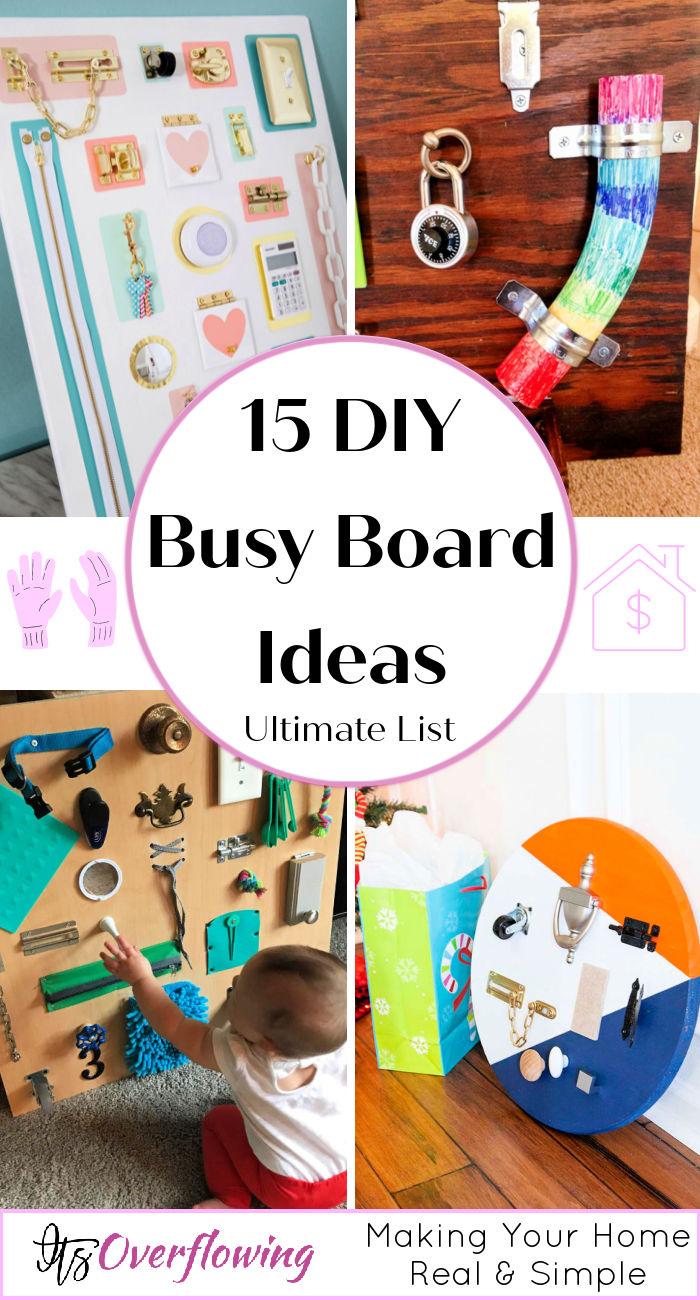
Why Build a DIY Busy Board
Making a DIY busy board can be a gratifying project that not only provides your children with endless hours of entertainment but also aids in their development. Here’s why crafting your own busy board is a fantastic idea:
- Personalization: A DIY busy board allows you to tailor the features to your child’s interests and developmental stage. Whether your child loves locks, enjoys spinning wheels, or is fascinated by textures, you can incorporate these elements into your design.
- Cost-Effective: Commercially available busy boards can be expensive. Crafting your own can be a more budget-friendly option, especially since you can repurpose materials you already have at home, such as old buttons, fabric scraps, or unused containers.
- Skill Development: Busy boards are excellent tools for enhancing motor skills, cognitive abilities, and sensory processing. Through play, children learn cause and effect, improve their problem-solving skills, and refine their fine motor skills by manipulating small objects.
- Bonding Time: Building a busy board for or with your child can be a bonding experience. It’s an opportunity to spend quality time together, working towards a common goal, and building fond memories in the process.
- Sense of Achievement: There’s a unique sense of accomplishment that comes with completing a DIY project. Watching your child engage with something you’ve made just for them is incredibly rewarding.
By considering these points, you can make a meaningful and fun learning tool that your child will cherish. Plus, the process of making a busy board can be just as enjoyable as seeing your child play with it.
How to Make a DIY Busy Board for Toddlers
Making a DIY busy board for toddlers can be an exciting and rewarding project. It provides a safe and interactive environment for your child to explore, enhancing their fine motor skills and cognitive development. Let’s dive into an easy-to-follow guide to make a busy board that’s both fun and educational.
Choose Your Board
Firstly, select the base for your busy board. A sturdy piece of plywood or MDF (Medium-Density Fiberboard) works well. Make sure the edges are smooth to avoid any splinters. You can either leave it natural or paint it with non-toxic, child-safe paint for a splash of color.
Gather Materials
Next, gather various items to attach to the board. Think about objects that will intrigue and challenge your toddler, such as:
- Locks and latches
- Knobs and handles
- Wheels and spinners
- Light switches and doorbells
- Fabric patches with different textures
- Zippers and buckles
Ensure all items are safe for children, with no sharp edges or small parts that could pose a choking hazard.
Plan Your Layout
Before attaching anything, lay out all your materials on the board to decide on placement. This step helps ensure there’s enough space for everything and that the board will be balanced.
Attach the Items
Once you’re happy with the layout, it’s time to secure the items. Depending on the object, you might need screws, bolts, or strong adhesive. If using screws or bolts, ensure they’re tightly fastened and that no sharp points protrude at the back of the board.
Add a Personal Touch
Personalize the busy board with your child’s name or favorite colors. You can also attach pictures behind doors or flaps for a fun surprise.
Secure the Busy Board
For safety, make sure the busy board is securely mounted or placed in an area where it won’t tip over while your child plays. If you prefer to hang the board, attach brackets to the back and secure it to a wall, out of reach of your child’s bed or furniture they might climb on.
Introduce the Board to Your Toddler
Once the board is complete, show it to your toddler. Demonstrate how some of the items work, but let them explore and figure out things on their own. This exploration is key to their learning and development.
Making a DIY busy board is not just about crafting a toy; it’s about offering your child a unique tool for exploration and learning. By following these steps, you’ll not only provide a safe and stimulating play option for your toddler but also enjoy the process of making it. Remember, the goal is to engage your child’s curiosity and develop their skills through play.
FAQs on DIY Busy Boards
Making a DIY busy board can be a fun and rewarding project. Here are answers to some of the most common questions to help you get started on making a stimulating and educational busy board for kids.
What is a busy board?
A busy board is a board with various items and gadgets attached to it, such as locks, knobs, bells, and gears, designed to stimulate learning and development in young children through play. They help in improving fine motor skills and cognitive abilities.
What materials do I need to make a DIY busy board?
Typically, you’ll need:
- A board (plywood or MDF are popular choices)
- Various items to attach (door latches, old phone, fabric textures, mirrors, etc.)
- Screws, nuts, and bolts to secure items
- A drill and screwdriver
- Safe, non-toxic paint or varnish (optional)
How do I choose items for my busy board?
When selecting items for your busy board, consider the age and developmental stage of the child. Ensure all pieces are safe — no sharp edges, small parts that could be swallowed, or toxic materials. Variety is key; include items that can be turned, twisted, opened, closed, slid, or spun.
Can I make a busy board for a baby?
Absolutely! For babies, focus on simple items that encourage sensory exploration. Soft fabrics, large colorful buttons, and mirrors are great options. Ensure everything is securely attached and there are no small, detachable parts that could pose a choking hazard.
How do I secure the items on the board?
Use screws, bolts, or heavy-duty glue to attach items firmly to the board. Make sure nothing can be easily pulled off by little hands and that all edges are smooth to prevent injuries.
Any safety tips I should consider?
- Smooth Edges: Ensure all items and the board itself have smooth edges.
- Non-toxic Materials: Use only non-toxic materials and paints.
- Regular Checks: Regularly inspect the board for loose parts or wear and tear.
- Supervised Play: Always supervise young children while they play with the busy board.
How can I make the busy board educational?
Integrate items that promote learning numbers, letters, colors, and shapes. For example:
- Attach alphabet letters in different textures.
- Include counting beads or a simple abacus.
- Use color-coded keys and locks.
- Add shape sorters with basic geometric shapes.
Can I update the busy board as my child grows?
Yes, it’s a great idea! As your child develops, you can replace simpler items with more complex ones to continue challenging them and supporting their learning.
Is it possible to make a portable busy board?
Yes, for a portable version, consider using a smaller board or a fabric mat where items can be attached with Velcro. Ensure it’s lightweight and that items are securely fastened to withstand travel.
How do I clean and maintain the busy board?
Wipe the board down with a damp cloth regularly. Avoid harsh chemicals near the play area. Check and tighten any loose parts and replace items as needed to keep the board safe and engaging.
Making a DIY busy board is not just about providing fun for children; it’s about stimulating their development in a safe and creative way. Hopefully, these FAQs will help you embark on this rewarding project with confidence.
15 Homemade DIY Busy Board Ideas
Discover 15 homemade DIY busy board ideas for kids to stay entertained and engaged. Engage their minds with these fun and interactive activities!
1. How to Make a Toddler Busy Board
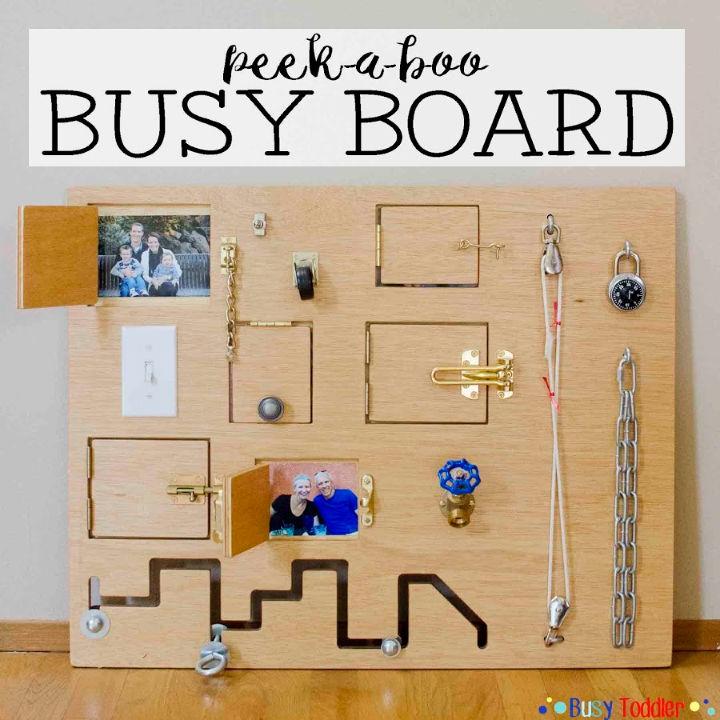
Make a Peek-a-Boo Busy Board with guidance from Busy Toddler and give your little ones an exciting, educational play experience. This DIY project involves assembling a variety of locks, switches, and sensory elements onto a plywood board, complete with hidden photo reveals for a personal touch.
It’s a fantastic way to engage toddlers in imaginative play while developing their fine motor skills and cognitive abilities. With an easy-to-follow approach, your family can enjoy crafting a toy that’s sure to become a cherished part of your child’s playtime routine. Get ready to build a unique and stimulating busy board that will entertain for years to come!
2. Easy DIY Busy Board for Babies

Making a busy board for toddlers is an engaging project that can keep little ones occupied while fostering their curiosity and motor skills. At Craft Her Way, a guide is available to help you make a DIY busy board filled with a variety of textures and gadgets.
From securing items to the board to choosing safe and stimulating components, the tutorial provides step-by-step instructions to ensure a successful crafting experience. It’s a resourceful way to repurpose household items, encouraging creativity and thriftiness. With clear, helpful advice, parents and caregivers can construct a playful learning tool that toddlers will love exploring.
3. Building a Busy Board for Toddlers
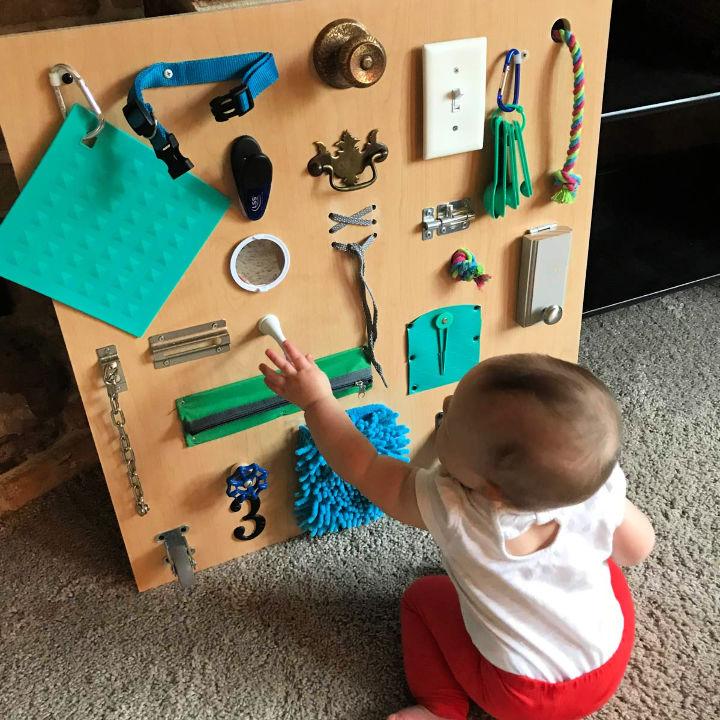
Making a DIY toddler busy board is a fun and engaging way to repurpose items you already have into a stimulating activity for your little one. Family Handyman‘s guide walks you through the simple steps to assemble a board that will keep your child entertained and help develop their motor skills.
Start with a smooth, safe base like MDF or an old cabinet door, and attach a variety of household objects such as knobs, latches, and wheels. Ensure all items are securely fastened and free of sharp edges for your child’s safety. By crafting this homemade busy board, you provide an exploratory play experience that’s both educational and enjoyable.
4. DIY Toddler Busy Boards With Tools
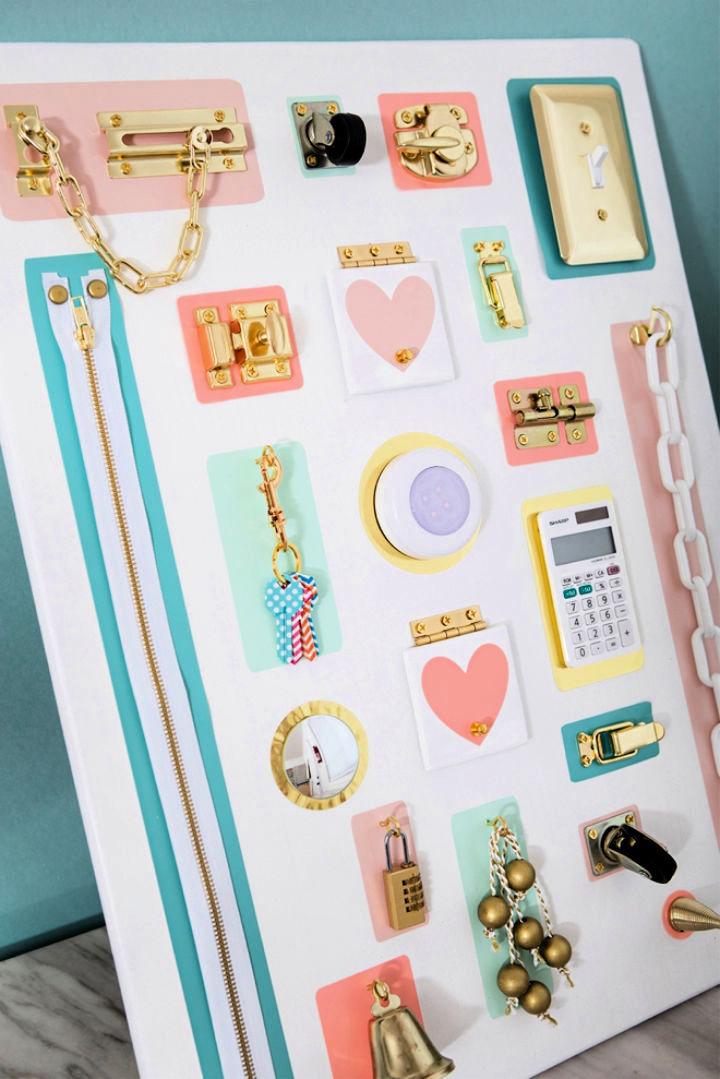
Making a toddler busy board is a fun and rewarding DIY project that can keep your little ones engaged and learning. Something Turquoise‘s tutorial simplifies the process, showing you how to craft a busy board without the need for power tools.
With a selection of everyday items like locks, hinges, and light switches, you can design a sensory experience that encourages exploration and fine motor skill development. Painting and personalizing the board adds a special touch, making it a unique addition to your child’s playtime. Whether it’s for at-home entertainment or on-the-go distraction, this step-by-step guide ensures a delightful outcome for both you and your toddler.
5. Simple Homemade Busy Board
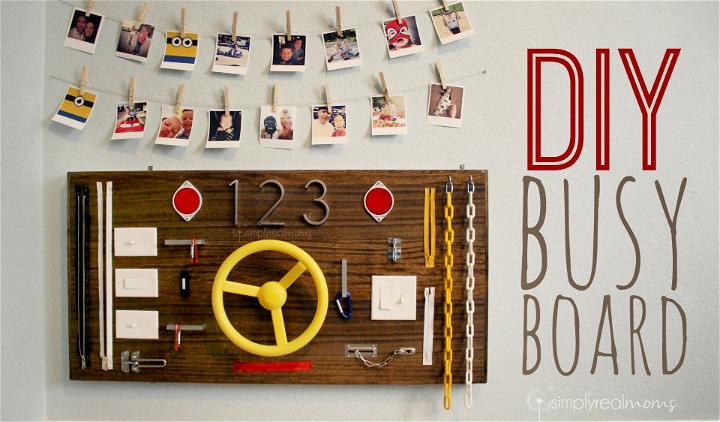
Transform your kids’ shared bedroom into a playful sanctuary with a DIY Busy Board, as featured on Hello Sensible. This hands-on project not only declutters your living space by offering a dedicated play area but also sparks imagination and fine motor skill development. Gather a mix of engaging hardware items like light switches, locks, and colorful zippers, and mount them onto a sturdy plywood board.
With an instructive approach, this guide provides step-by-step details to make a custom, interactive toy that promises long-lasting entertainment for children. Keep it simple or get creative with flush-mounted switches for a polished look. Remember, while this engaging board requires some investment, the joy and developmental benefits it brings to your little ones are invaluable.
6. Make Your Own Toddler Busy Boards
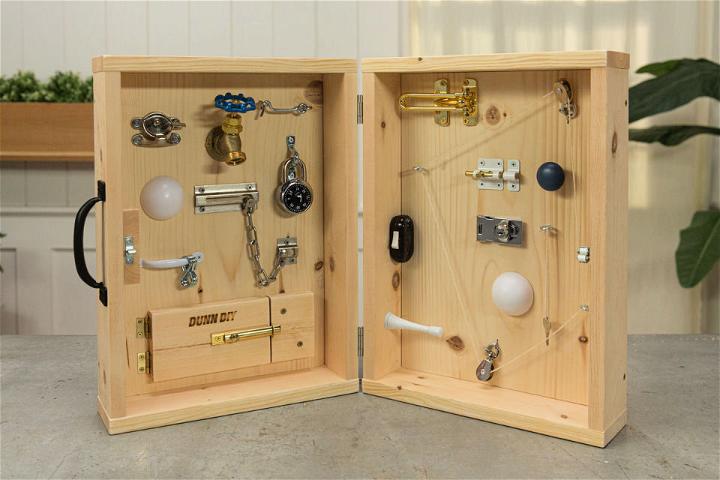
Making a DIY toddler busy board is an enjoyable project that can provide endless entertainment for little ones. At Dunn DIY, we guide you through the process of crafting a board filled with intriguing gadgets like handles, locks, and switches that captivate young minds.
With our step-by-step instructions, you can build a safe, durable, and educational toy that encourages exploration and fine motor skill development. Our helpful tips ensure your busy board is perfectly suited to the developmental stages of toddlers, fostering a sense of achievement as they master each new challenge. Get ready to make playtime both fun and rewarding with your homemade busy board.
7. How to Build a Busy Board at Home
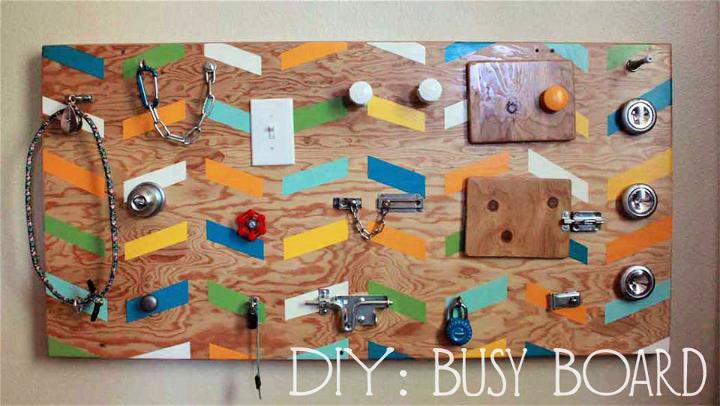
Making a busy board is a brilliant way to stimulate your little one’s curiosity and motor skills. Our DIY guide walks you through crafting a wall-mounted activity center with a variety of engaging gadgets. From locks and latches to knobs and switches, this project, while not the cheapest, promises hours of educational fun for your child. Learn how to select and assemble materials, paint a charming design, and safely secure your creation for your child’s enjoyment. Dive into this hands-on project and give your toddler the gift of exploration and learning. Our Home-grown Spud
8. DIY Wooden Busy Board for Kids
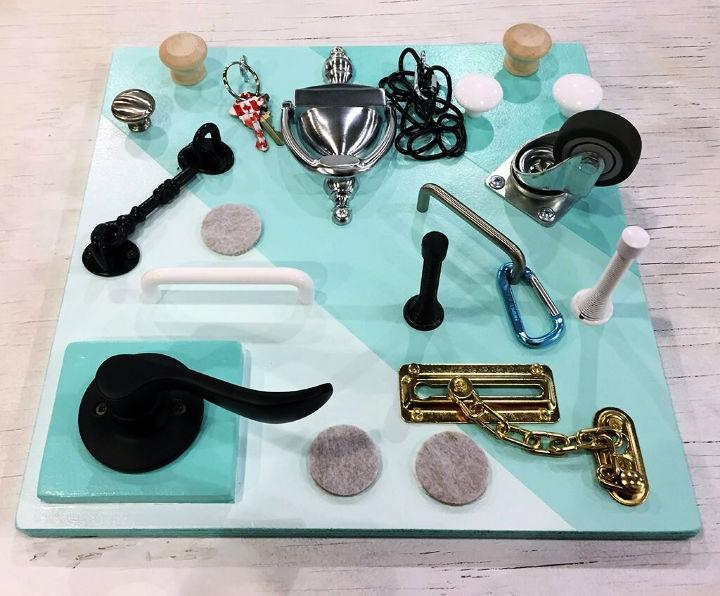
Making a Busy Board for kids is a fun and educational DIY project that can keep little hands and minds engaged. At POCO Building Supplies, we understand the importance of fostering curiosity in young children through safe and interactive play. A Busy Board offers a tactile and sensory experience that can aid in the cognitive development of toddlers.
It’s a customizable activity, allowing you to add various elements like door stoppers, knobs, and locks that will captivate your child’s attention. Just select a smooth board, plan your layout, drill the necessary holes, apply a vibrant color scheme, and securely mount the chosen hardware. With this instructive guide, you’ll be able to craft a unique Busy Board that’s perfect for your little one’s exploration and playtime.
9. Making a Toddler Learning Busy Board
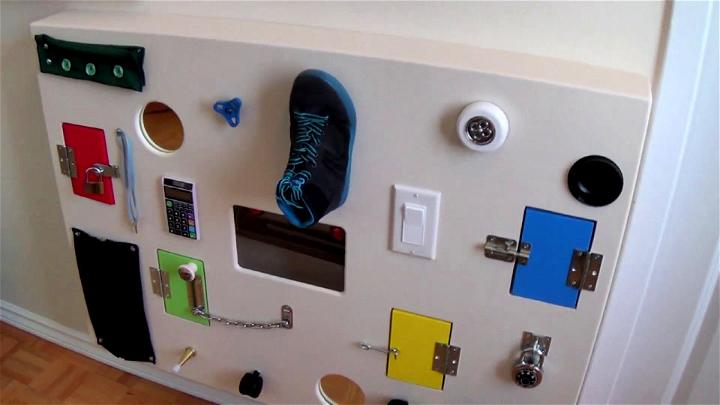
Engage your toddler with a homemade DIY Learning Busy Board, as showcased on YouTube. This interactive board, crafted from painted 5/8 MDF, offers a hands-on educational experience that combines fun and learning. It features four doors with different latches and hidden pictures, stimulating curiosity and fine motor skills.
Additional elements like buttons, a zipper, a shoe with laces, and a light with a switch powered by 9V batteries encourage tactile exploration. Plus, a ball slide adds an extra touch of enjoyment. Perfect for little ones eager to explore, this busy board is an excellent tool for parents and educators to support child development through play.
10. How to Make a Wooden Busy Board
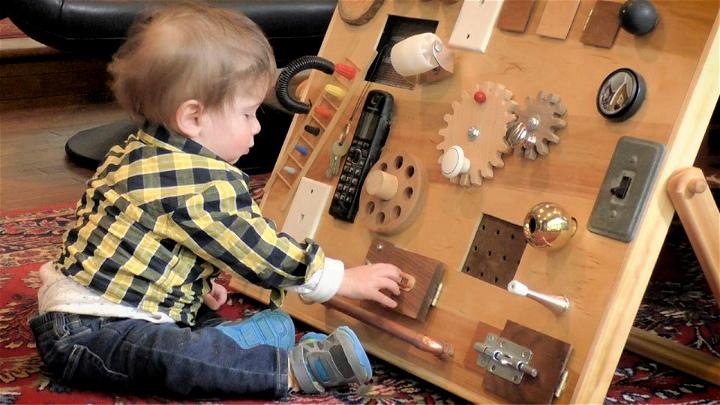
Embark on a delightful DIY journey with the Busy Board Part 6 project, perfect for stimulating young minds! This final installment focuses on wiring LED lights and adding personalized touches to make an engaging and educational play area for toddlers. Essential materials include LED strip lights, a battery holder, and basic tools like clamps and solder.
Follow easy steps to assemble and customize your board with family photos and unique items like tree branches. This project not only lights up with creativity but also offers endless fun and learning opportunities for little ones. Perfect for parents and caregivers looking to craft a special gift that combines love, learning, and light!
11. Build a Busy Board With Step by Step Guide
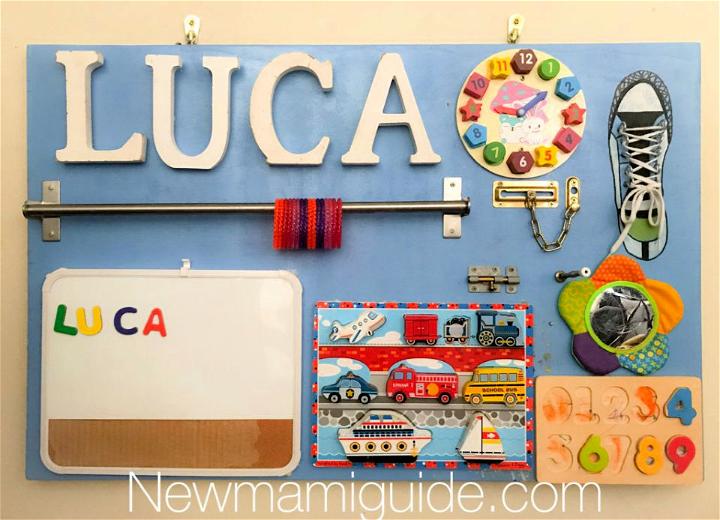
Making a DIY Busy Board is a fantastic way to engage and stimulate your baby’s developing senses and motor skills. This step-by-step guide will help you craft a personalized and safe play area for your little one. Start by selecting a smooth, splinter-free wooden board and consider sanding it for extra safety. Optionally, you can paint the board for a splash of color.
Gather essential tools like screws, a power drill, and about 30 minutes of your time. When attaching items like wooden letters, locks, and a soft baby mirror, ensure everything is securely fastened to withstand your baby’s curious hands. Remember to avoid sharp edges and breakable materials for your child’s safety. With these tips, you’re all set to make an engaging busy board that your baby will adore. New Mami Guide
12. DIY Busy Board That Really Entertains
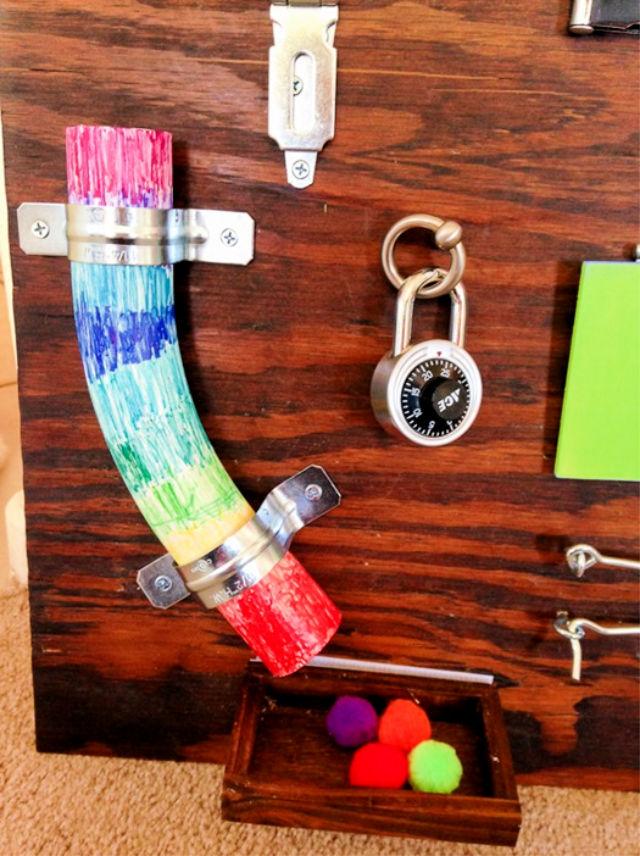
Making a toddler busy board is a fantastic way to engage your little one’s curiosity and develop their fine motor skills. Hands On As We Grow® shares an innovative idea for a supernova busy board that promises to keep toddlers entertained for hours. From spinning wheels and pop lights to colorful wooden letters and security locks, this board has a variety of elements to explore.
Not only is it a fun project to assemble, but it also offers a unique way to integrate learning and play. Gather some old toys, PVC pipe, bells, and more to craft a sensory-rich playground for your toddler. With a sturdy backboard and a splash of creativity, you can make an educational masterpiece that’s both functional and stylish for your home.
13. Handmade Busy Board for Kids
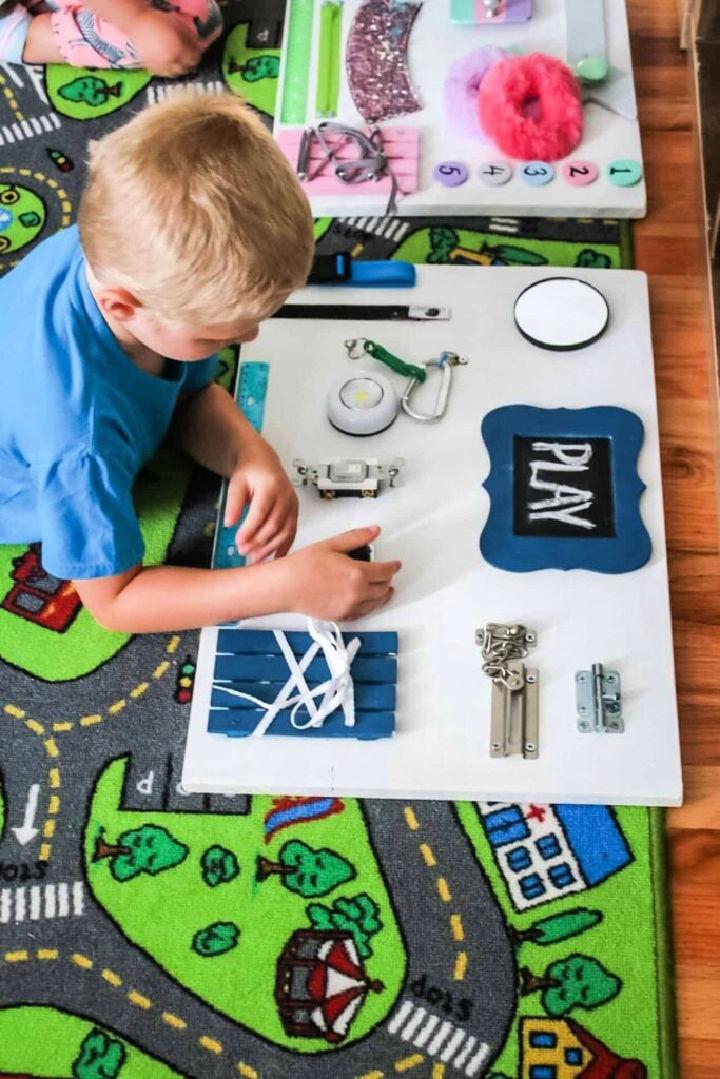
Make your own busy boards with ease by following the step-by-step guide from Cottage On Bunker Hill. Jennifer Howard showcases how to craft two distinct boards: one designed to enhance fine motor skills and another rich with sensory textures.
Discover how to repurpose items from your home and find affordable materials at stores like Dollar Tree to assemble engaging and educational boards for toddlers. With practical tips on using tools like Gorilla Glue and screws for secure attachments, these DIY busy boards are sure to captivate and educate little ones while promoting self-dressing skills and sensory exploration.
14. Adorable DIY Children’s Sensory Board
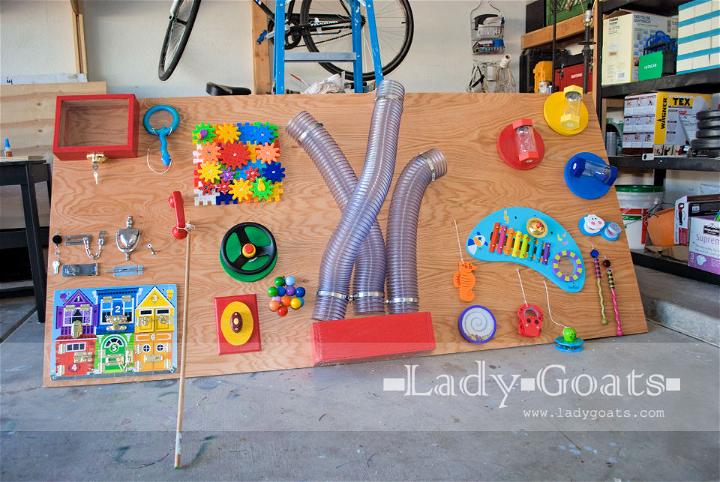
Making a sensory board for children is an engaging project that can add an educational and interactive element to any preschool or daycare environment. If you’re inspired to craft a sensory board, this guide offers a creative approach to making one that is not only fun for kids but also ensures their safety.
Using formaldehyde-free Purebond Plywood as a base, this sensory board features a variety of tactile elements like ball chutes made from durable dust collector hose and a shadow box with a locking sash to secure its contents. With thrift store finds and new items like doorbells and sand timers, each board can be unique. For those ready to make an enriching experience for little ones, this guide will walk you through the steps and materials needed for a successful build. Keep an eye out for updates with photos of the completed board in its educational setting! Lady Goats
15. Easy Steps to Make a Toddler Busy Board
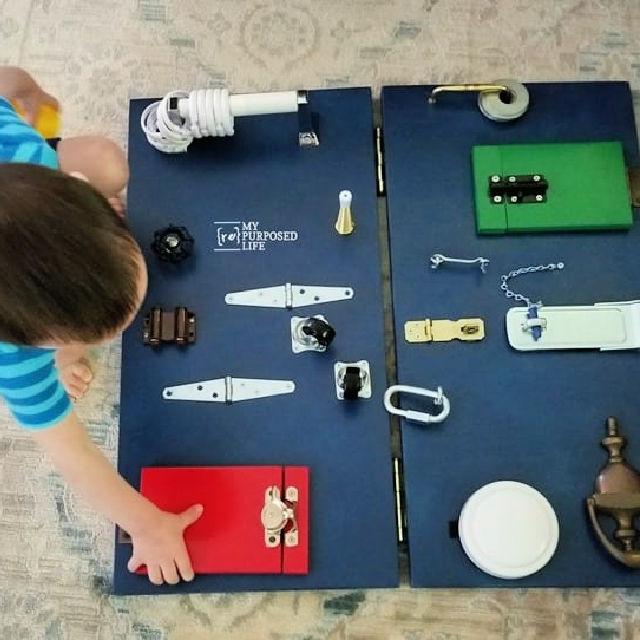
Engage your toddler with a DIY Busy Board, a creative project featured on My Repurposed Life®. Perfect for hands-on learning, this board utilizes old hardware to develop fine motor skills and keep little ones entertained. Follow Gail Wilson’s instructive guide to assemble a colorful and interactive busy board using simple plywood and a variety of tactile components such as latches, wheels, and door knockers.
Painting and securing the elements is made easy with helpful tips, ensuring a sturdy and vibrant result. Ideal for parents and caregivers, this busy board slips neatly away when playtime is over. Dive into crafting a fun and educational toy that your toddler will love exploring time and again.
Conclusion:
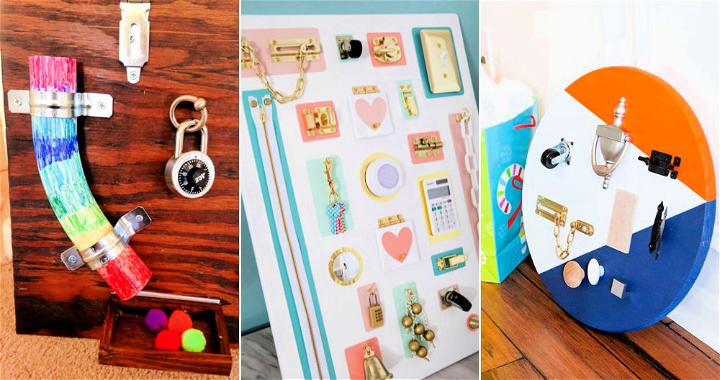
In conclusion, exploring 15 homemade DIY busy board ideas offers a gateway to crafting engaging, educational tools for toddlers right at home. This guide underscores the importance of choosing the right materials, planning your layout, and securing the items to ensure a safe and stimulating play environment.
Remember, adding a personal touch not only makes the busy board special but also tailors the learning experience to your child’s development. We hope this how-to guide inspires you to make a DIY busy board that will captivate your toddler’s imagination and enhance their learning journey.
